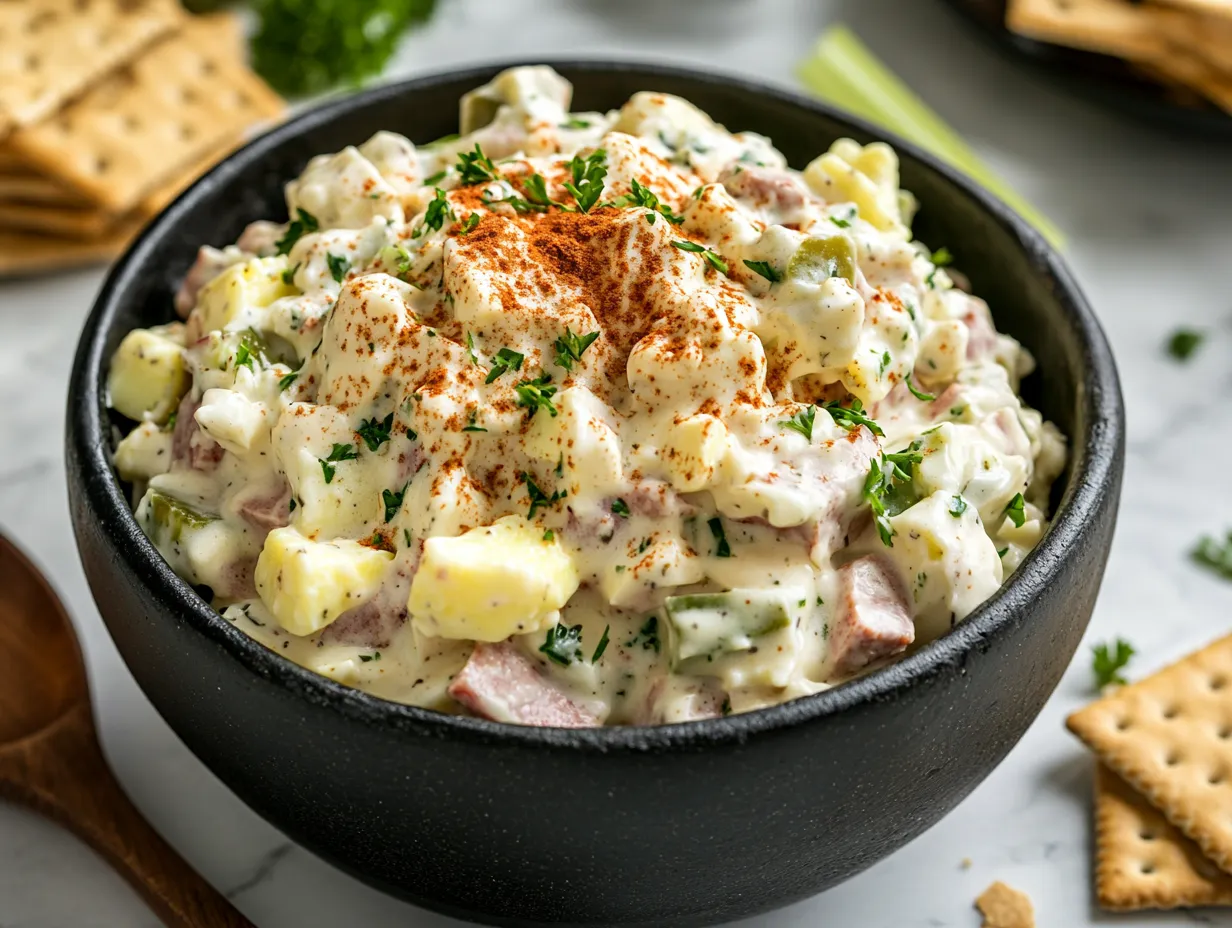Greek Spaghetti embodies the essence of Mediterranean cuisine, offering a delightful fusion of flavors that cater to a wide array of palates. This dish, while simple in its ingredients, is profound in taste, combining the robustness of olive oil, the tanginess of feta cheese, and the freshness of vegetables like cherry tomatoes and spinach. It’s a testament to the versatility and richness of Greek cooking, which emphasizes the use of fresh, wholesome ingredients to create meals that are both nutritious and flavorful.
The history of Greek Spaghetti is as rich as its flavors. Rooted in the Mediterranean diet, this dish reflects the culinary traditions of Greece, where pasta meets the vibrant ingredients typical of the region. The incorporation of olive oil, a staple in Greek cooking, not only enhances the flavor but also adds a layer of health benefits, aligning with the diet’s focus on heart-healthy fats. For more insights into the traditional Greek cuisine, explore “Traditional Greek Cuisine” on Wikipedia.
Cultural significance plays a pivotal role in the popularity of Greek Spaghetti. It’s a dish that transcends mere sustenance, embodying the Greek ethos of family, hospitality, and the joy of sharing meals. The simplicity of its preparation and the flexibility in its ingredients make it a favorite among home cooks and chefs alike. For inspiration and a variety of recipes, Pinterest offers a wealth of “Greek Spaghetti Inspiration”.
Ingredients and Variations
Ingredients
The beauty of Greek Spaghetti lies in its simplicity and the quality of its ingredients. Each component plays a crucial role in creating a harmonious dish that is both satisfying and healthy. Here’s a breakdown of the essential ingredients:
- Spaghetti: The base of the dish, spaghetti noodles are preferred for their texture and ability to hold the dressing. However, any type of pasta can be used, making it a versatile choice for this recipe.
- Olive Oil: A key element in Mediterranean cooking, olive oil not only adds depth and richness to the dish but also brings health benefits, being a source of monounsaturated fats. Learn more about the “Benefits of Olive Oil in Cooking” on Wikipedia.
- Red Onion and Garlic: These aromatics provide a sharp, pungent base that enhances the overall flavor profile of the dish.
- Red Wine Vinegar: Adds acidity and brightness, balancing the richness of the olive oil and cheese.
- Seasonings: Dried oregano, fresh basil, kosher salt, and ground black pepper add layers of flavor, embodying the essence of Greek cuisine.
- Lemon Juice: The acidity from lemon juice lifts the dish, adding a fresh, zesty note.
- Vegetables: Cherry tomatoes and baby spinach contribute sweetness and a slight bitterness, respectively, adding complexity and nutrition.
- Feta Cheese: Crumbled feta adds a creamy texture and a salty tang, rounding out the flavors.
- Kalamata Olives: These olives are a Greek staple, adding a briny depth.
Each ingredient in Greek Spaghetti plays a symphony of flavors and textures, making every bite a delightful experience.
Variations
Part 1: Dressing and Vegetables
One of the most appealing aspects of Greek Spaghetti is its adaptability. Starting with the dressing, while the classic recipe calls for a homemade blend of olive oil and red wine vinegar, there’s room for personalization. For those short on time or looking for convenience, a store-bought Greek dressing can be a quick alternative, though making it from scratch allows for customization of flavors to personal taste. For a deeper dive into making your own dressings and their impact on dishes, Pinterest provides a plethora of “Cooking with Basil” ideas, which can inspire variations in the dressing.
When it comes to vegetables, the recipe is equally flexible. The traditional trio of cherry tomatoes, baby spinach, and kalamata olives offers a balance of sweet, bitter, and briny flavors. However, the dish can easily be tailored to what’s available or preferred. Adding cucumbers can introduce a refreshing crunch, while bell peppers can add sweetness and color. For those looking to explore more about the versatility of vegetables in Mediterranean dishes, the “Kalamata Olives: A Greek Delight” article on Wikipedia provides insight into one of the key ingredients and its role in Greek cuisine.
Part 2: Pasta, Vinegar, and Protein
The choice of pasta in Greek Spaghetti can vary widely beyond the traditional spaghetti noodles. Gluten-free options are readily available for those with dietary restrictions, and shapes like bow-tie or shells can make the dish more visually appealing and fun for kids. This flexibility ensures that the dish can be enjoyed by everyone, regardless of dietary needs or preferences. For more information on pasta types and their uses, the “Exploring Types of Pasta” page on Wikipedia is a valuable resource.
In terms of vinegar, while red wine vinegar is preferred for its fruity and mild acidity, white wine vinegar can serve as a suitable substitute, offering a slightly different but equally delicious flavor profile. For those without either, a splash of lemon juice or even balsamic vinegar can provide the necessary acidity to balance the dish. This adaptability in ingredients underscores the dish’s Mediterranean roots, where cooking is often about improvisation and making the most of what’s available.
Adding protein to Greek Spaghetti transforms it from a side dish to a hearty main. Grilled chicken, shrimp, or even chickpeas can be mixed in to add texture and nutritional value, making the dish more filling and satisfying. This versatility not only caters to different dietary preferences but also showcases the dish’s ability to be customized for any occasion, from a simple family dinner to a more elaborate gathering. For those interested in incorporating more protein into their meals, Pinterest’s “Pasta Recipe Ideas” can offer creative ways to do so while maintaining the dish’s Greek essence.
In conclusion, the variations possible with Greek Spaghetti are nearly endless, allowing cooks to tailor the dish to their tastes, dietary needs, or whatever ingredients they have on hand. This adaptability, combined with the rich flavors and healthy ingredients typical of Mediterranean cuisine, makes Greek Spaghetti a versatile and beloved dish in kitchens around the world.
Cooking Process
Part 1: Preparing the Ingredients and Pasta
The journey to a delicious Greek Spaghetti begins with the preparation of ingredients, a process that sets the foundation for the flavors to come. Start by finely dicing the red onion and mincing the garlic cloves, ensuring they are small enough to distribute evenly throughout the dish. This step is crucial as it allows the aromatics to meld seamlessly with the olive oil, creating a fragrant base for the dressing.
Next, cook the spaghetti according to the package instructions until it is al dente. This term, meaning “to the tooth” in Italian, refers to pasta that is cooked to be firm to the bite. Achieving this texture is essential for Greek Spaghetti, as it ensures the pasta holds up well when mixed with the dressing and vegetables. To prevent the noodles from sticking together, add a tablespoon of olive oil to the cooking water, a trick that adds flavor while ensuring the perfect texture. For those interested in the science behind cooking pasta perfectly, the “Exploring Types of Pasta” article offers insights into different pasta shapes and their cooking times.
While the pasta cooks, halve the cherry tomatoes and slice the kalamata olives, preparing them to be tossed into the dish. These ingredients, along with the baby spinach, should be ready to go as soon as the pasta is drained. The key to a vibrant Greek Spaghetti is adding these vegetables while the pasta is still warm, allowing the heat to slightly wilt the spinach and warm the tomatoes and olives, enhancing their flavors.
Part 2: Assembling the Dish
Once the pasta is cooked and drained, reserve a quarter cup of the pasta water before returning the spaghetti to the pot. This starchy water is a secret weapon in creating a silky, emulsified sauce that clings to the pasta, ensuring every strand is flavorful. In a large skillet, sauté the diced onions in a tablespoon of olive oil until they are soft and translucent. Add the minced garlic and cook for an additional minute, just until fragrant, being careful not to let it brown.
Introduce the cherry tomatoes to the skillet, cooking them until they start to soften and release their juices. This step not only concentrates the tomato flavor but also creates a natural sauce that will coat the pasta beautifully. Add the baby spinach and cook until just wilted, which should take no more than a minute. The spinach should retain some of its texture and vibrant green color, adding a fresh element to the dish.
To assemble the Greek Spaghetti, add the sautéed vegetables to the pot with the pasta, along with the sliced kalamata olives, lemon juice, red wine vinegar, and the remaining olive oil. Toss everything together, gradually adding the reserved pasta water until the desired consistency is reached. The dressing should lightly coat the pasta without pooling at the bottom of the pot.
Finish the dish by folding in the crumbled feta cheese and fresh basil leaves, allowing the residual heat to slightly melt the cheese and release the basil’s aroma. Serve the Greek Spaghetti warm, garnished with additional basil or parsley if desired. This final step brings all the components together, resulting in a dish that is a celebration of Mediterranean flavors, perfect for any occasion.
Serving Suggestions
Serving Greek Spaghetti offers a delightful opportunity to explore the versatility of this dish, whether it’s presented as a main course or a complementary side. Its rich, Mediterranean flavors pair beautifully with a variety of proteins and salads, making it a flexible option for any meal. Here are some serving suggestions to elevate your Greek Spaghetti experience:
- As a Main Dish: When serving Greek Spaghetti as the centerpiece of your meal, consider adding grilled chicken, fish, or shrimp on top for a protein boost. These options not only complement the flavors of the pasta but also transform it into a more substantial, satisfying meal. For those looking for a vegetarian option, chickpeas or white beans can provide a hearty, protein-rich alternative.
- With Salads: A crisp, refreshing salad is the perfect accompaniment to the rich flavors of Greek Spaghetti. Consider a Greek cucumber salad, which offers a crunchy, vinegary contrast to the pasta, or a simple arugula salad dressed with lemon and olive oil for a peppery bite. These salads add a fresh dimension to the meal, balancing the heartiness of the pasta.
- Bread Pairings: No Mediterranean meal is complete without bread. Serve your Greek Spaghetti with a side of warm, crusty bread or pita to soak up any remaining dressing. For an extra touch of flavor, brush the bread with olive oil and a sprinkle of garlic powder before toasting.
- Wine Pairings: To complement the flavors of the dish, select a wine that balances the acidity and richness of the pasta. A crisp, dry white wine like a Sauvignon Blanc or a light, fruity red wine such as a Pinot Noir can enhance the dining experience, making each bite of the Greek Spaghetti even more enjoyable.
By considering these serving suggestions, you can create a well-rounded, flavorful meal that showcases the best of Mediterranean cuisine. Whether enjoyed on its own or as part of a larger feast, Greek Spaghetti is a versatile dish that promises to delight and satisfy.
FAQs
Can I use frozen spinach instead of fresh in the recipe?
Yes, frozen spinach can be a convenient alternative to fresh spinach in Greek Spaghetti. If opting for frozen, ensure it’s thoroughly thawed and excess water is squeezed out before adding it to the dish. Use about 1 1/2 cups of frozen spinach as a substitute for the fresh quantity specified in the recipe. While the texture may slightly differ, frozen spinach still provides the dish with its characteristic flavor and nutritional benefits.
What is the best way to reheat leftover Greek Spaghetti?
Leftover Greek Spaghetti can be easily reheated to enjoy again. For the best results, place it in a microwave-safe dish and cover lightly. Heat on medium power, stirring occasionally, until warmed through. Alternatively, reheat it in a skillet over medium heat with a splash of water or additional olive oil to prevent the pasta from drying out. This method helps to revive the flavors and maintain the dish’s moisture.
How long can I store leftover pasta?
Properly stored, leftover Greek Spaghetti can last in the refrigerator for 4-5 days. Ensure it’s placed in an airtight container to maintain freshness and prevent it from absorbing odors from other foods. Before serving again, give the pasta a good stir or toss to redistribute the dressing and ingredients evenly. This storage tip ensures that your Greek Spaghetti remains delicious and safe to enjoy for several days after preparation.
Print
Greek Spaghetti
- Author: Naomi
- Total Time: 35 minutes
- Yield: 4-6 servings
Description
Greek Spaghetti is a vibrant and flavorful dish that combines the hearty essence of Mediterranean cuisine with the comfort of pasta. This recipe brings together al dente spaghetti, rich olive oil, tangy feta cheese, and a medley of fresh vegetables, including cherry tomatoes, baby spinach, and kalamata olives.
Ingredients
Instructions
Notes
- Ingredient Flexibility: This recipe is highly adaptable. Feel free to substitute the vegetables with whatever you have on hand or prefer. Similarly, the pasta can be swapped for gluten-free or whole wheat varieties to suit dietary needs.
- Protein Addition: For a more substantial meal, consider adding grilled chicken, shrimp, or chickpeas to the mix. This not only increases the protein content but also adds another layer of flavor.
- Make Ahead: Greek Spaghetti is a great make-ahead dish. It can be prepared a day in advance, with flavors melding together overnight in the refrigerator, enhancing its taste.
- Serving Temperature: While traditionally served warm, this dish is also delicious when served at room temperature, making it a versatile option for picnics or potlucks.
- Storage: Leftovers can be stored in an airtight container in the refrigerator for 4-5 days. The dish is easily reheatable, with a splash of water or olive oil to refresh its flavors.
- Prep Time: 15 minutes
- Cook Time: 20 minutes
- Category: Dinner
- Cuisine: American









